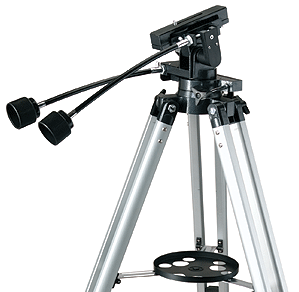Celestron Heavy Duty Alt-Azimuth Tripod By Chuck Hawks  Celestron's Heavy Duty Alt-Azimuth Tripod is particularly suitable for astronomical observing. They recommend this tripod for use with any of their giant binoculars as well as their C-90, C-130 and C5 spotting scopes, indicating confidence in its rigidity. It is also a good choice for similar scopes from other manufacturers, such as the Meade ETX 90mm CAT, as long as they are provided with a standard ¼"x20 threaded tripod attachment. Here are the basic specifications and features of the Celestron Heavy Duty Alt-Azimuth Tripod:
The Heavy Duty Tripod comes with sturdy aluminum legs, an
accessory tray that screws to the center brace (the tray must be removed to
fold the tripod) and a heavy duty head with flexible slow motion cables for
adjusting altitude and azimuth. Attachment to the long, narrow head is by means
of a standard ¼"x20 tripod mounting screw. This tripod provides a steady
platform for spotting scopes and small astronomical telescopes. When the tripod arrived I discovered that, while there is a conventional knob that can be loosened to pan the head 360 degrees, there is no knob that can be loosened to make gross altitude (pitch) adjustments. A ¾ inch hex nut on the left side of the head adjusts the friction tension for pitch. This nut must be torqued so that the head will hold the scope at any pitch angle without slipping, yet loose enough so that the telescope can be aimed at the altitude desired. It would be wise to carry a suitable wrench with the tripod. A knob that can be tightened or loosened by hand to make altitude adjustments would be a big improvement. I tested the Heavy Duty Tripod with Celestron 25x100mm giant binoculars and a Meade ETX-90mm Astro catadioptric telescope. The latter was used on its motorized fork mount as well as dismounted (just the optical tube with its finder scope). In the latter configuration, it made an excellent combination for quick set-up and casual observation. When I mounted the 25x100 giant binoculars on the tripod, it became apparent that the azimuth slow motion control cable/knob interfered with the binocular at high altitude viewing angles. The only way to alleviate the problem was to remove the azimuth cable/knob, thus rendering the azimuth slow motion control unusable. A simple knob without the flexible cable extension would be desirable for use with binoculars. The slow motion altitude cable knob does not directly interfere with the binoculars, but it continually pokes the operator in the chest or neck. A shorter cable/knob would be appropriate here. Even when fully extended, the tripod's two section legs are not tall enough to allow anyone to stand upright and view the sky when the binocular is pointed upward. I had to squat low to the ground to see through the binoculars when they were aimed skyward. This is not only very uncomfortable, it simply is not an adequately steady position for astronomical viewing. Even for terrestrial viewing with the binoculars horizontal, I had to crouch. Some sort of stool or chair would seem to be the solution for terrestrial viewing. However, for astronomical observing, because the height of the eyepieces changes radically as the long binocular is pointed up and down, no single height stool will correctly position the head and eyes. In addition, to look straight up (vertically) through binoculars, the head must be tilted back 90 degrees from horizontal, which is not practical when sitting on a stool. The bottom line is that the Celestron Heavy Duty tripod can be used with giant binoculars for terrestrial viewing, but for astronomical purposes the tripod was clearly intended for use with a telescope equipped with a 90-degree star diagonal, not binoculars. For refracting or catadioptric telescopes so equipped, its height is about right and it provides a sturdy mount. Further proof of the tripod's telescope heritage is that the accessory tray has cut-outs for .96" and 1.25" telescope oculars. I can recommend this relatively lightweight, sturdy tripod for use with spotting scopes and small (about 90mm or smaller objective) astronomical telescopes. It worked reasonably well for visual observation with a Meade ETX-90 Astro, motor base and all, and the head can be tilted at the proper angle (about 44 degrees where I live) to take the place of a wedge for a swing arm mounted CAT scope like the Meade. For use with a spotting scope or small astronomical telescope in alt-azimuth mode, this tripod is ideal. However, I have to rate it a poor choice for use with giant binoculars. |